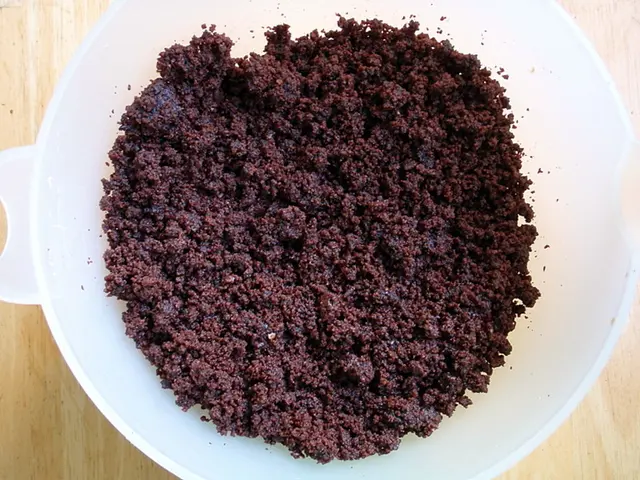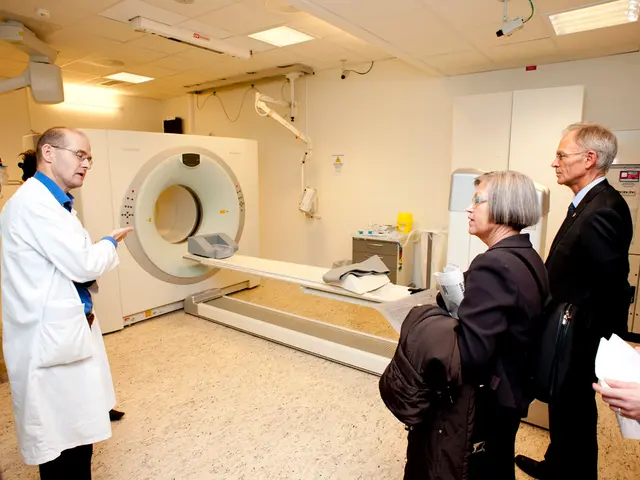Distinguishing between Age Spots and Skin Cancer: Recognizing the Variations
Spot the Difference: Age Spots, Skin Cancer, and Actinic Keratosis
Navigate through the complexities of age spots, skin cancer, and actinic keratosis with a no-nonsense approach. Dive into their distinctive features, symptoms, and treatments to make informed decisions about your skin's health.
Age Spots and Skin Cancer: A Closer Look
Cosmetic Compadres
- Age Spots: Appear as flat spots with varied color, most commonly brown or black, caused by sun exposure.
- Skin Cancer: Encompasses several types such as basal cell carcinoma, squamous cell carcinoma, and melanoma, each with unique appearances:
- Basal Cell Carcinoma: Often presents as a small, shiny bump or a pink, pearly patch.
- Squamous Cell Carcinoma: Can appear as a hard, red nodule or a flat, crusted lesion.
- Melanoma: Generally appears as a new or changing mole with irregular borders, multiple colors, or a larger size.
- Actinic Keratosis: Characterized by rough, scaly patches, often red, pink, tan, or brown in color, emerging on sun-exposed areas.
Marks, Symptoms, and Change
- Age Spots: Generally symptom-free and painless.
- Skin Cancer: May give rise to symptoms such as bleeding, itching, or changes in the size or color of a mole. In advanced stages, discomfort may increase.
- Actinic Keratosis: May be sensitive to touch and cause itching or stinging. If left untreated, it may lead to squamous cell carcinoma, causing more severe symptoms like crusting or bleeding.
Identifying the Issue
- Age Spots: Diagnosed through visual inspection and the client's personal history.
- Skin Cancer: Diagnosis requires a biopsy to examine the lesion's tissue.
- Actinic Keratosis: Diagnosed based on visual inspection, with a biopsy if required for suspicion of skin cancer progression.
Managing Your Skin Health
- Age Spots: Common treatments include topical creams, chemical peels, or laser therapy for cosmetic reasons.
- Skin Cancer: Treatment options vary based on the type and stage:
- Basal Cell Carcinoma: Requires surgical excision, radiation therapy, or Mohs surgery.
- Squamous Cell Carcinoma: May necessitate surgical excision, Mohs surgery, or radiation therapy.
- Melanoma: Requires surgical excision, possibly followed by radiation or immunotherapy.
- Actinic Keratosis: Prevent progression with topical creams (e.g., imiquimod, fluorouracil), cryotherapy, or laser therapy.
In a Nutshell
| Condition | Description | Symptoms | Diagnosis | Treatment ||------------------|-------------------------------|--------------|------------------|--------------------|| Age Spots | Small, flat, frequently brown or black spots | No common symptoms | Visual inspection | Topical creams, laser, chemical peels || Skin Cancer | Various types, each unique in appearance, symptoms, treatment methods | Bleeding, itching, changes in size or color | Biopsy | Surgery, radiation, immunotherapy || Actinic Keratosis | Rough, scaly patches, often red, pink, tan, or brown | Sensitivity, itching, or stinging | Visual inspection, biopsy | Topical creams, cryotherapy, laser |
Be vigilant about any changes to your skin, as early detection can improve health outcomes for skin conditions. If you notice anything unusual, speak with a healthcare professional.
- In the realm of oncology, melanoma is one of the types of skin cancer that can appear as a new or changing mole with irregular borders, multiple colors, or a larger size.
- Dermatology offers several treatment options for actinic keratosis, such as topical creams (like imiquimod or fluorouracil), cryotherapy, or laser therapy to prevent its progression to squamous cell carcinoma.
- Actinic keratosis, a skin condition characteristic of rough, scaly patches on sun-exposed areas, may be sensitive to touch and cause itching or stinging if left untreated.
- Other skin cancers, such as basal cell carcinoma and squamous cell carcinoma, require medical attention and can be diagnosed and treated by a healthcare professional in the field of medical-conditions.
- Age spots are merely cosmetic in nature, causing no common symptoms, and can be managed through various treatments like topical creams, chemical peels, or laser therapy for health-and-wellness purposes.








